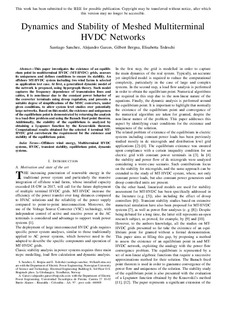| dc.contributor.author | Sanchez Acevedo, Santiago | |
| dc.contributor.author | Bergna-Diaz, Gilbert | |
| dc.contributor.author | Tedeschi, Elisabetta | |
| dc.contributor.author | Garces Ruiz, Alejandro | |
| dc.date.accessioned | 2019-04-10T06:30:45Z | |
| dc.date.available | 2019-04-10T06:30:45Z | |
| dc.date.created | 2019-01-11T12:41:04Z | |
| dc.date.issued | 2018 | |
| dc.identifier.issn | 0885-8950 | |
| dc.identifier.uri | http://hdl.handle.net/11250/2593923 | |
| dc.description.abstract | This paper investigates the existence of an equilibrium point in multiterminal HVDC grids, assesses its uniqueness and defines conditions to ensure its stability. An offshore multiterminal HVDC system including two wind farms is selected as application test case. At first, a generalized dynamic model of the network is proposed, using multigraph theory. Such model captures the frequency dependence of transmission lines and cables, it is non-linear due to the constant power behavior of the converter terminals using droop regulation, and presents a suitable degree of simplifications of the modular multilevel converters, under given conditions, to allow system level studies over potentially large networks. Based on this model, the existence and uniqueness of the equilibrium point are demonstrated by returning the analysis to a load-flow problem and using the Banach fixed point theorem. Additionally, the stability of the equilibrium is analyzed by obtaining a Lyapunov function by the Krasovskii's theorem. Computational results obtained for the selected 4 terminal HVDC grid corroborate the requirement for the existence and stability of the equilibrium point. | nb_NO |
| dc.language.iso | eng | nb_NO |
| dc.publisher | IEEE | nb_NO |
| dc.title | Dynamics and Stability of Meshed Multiterminal HVDC Networks | nb_NO |
| dc.type | Journal article | nb_NO |
| dc.type | Peer reviewed | nb_NO |
| dc.description.version | acceptedVersion | nb_NO |
| dc.source.journal | IEEE Transactions on Power Systems | nb_NO |
| dc.identifier.doi | 10.1109/TPWRS.2018.2889516 | |
| dc.identifier.cristin | 1654866 | |
| dc.relation.project | Norges forskningsråd: 258798 | nb_NO |
| dc.description.localcode | © 2018 IEEE. Personal use of this material is permitted. Permission from IEEE must be obtained for all other uses, in any current or future media, including reprinting/republishing this material for advertising or promotional purposes, creating new collective works, for resale or redistribution to servers or lists, or reuse of any copyrighted component of this work in other works. | nb_NO |
| cristin.unitcode | 194,63,20,0 | |
| cristin.unitname | Institutt for elkraftteknikk | |
| cristin.ispublished | true | |
| cristin.fulltext | preprint | |
| cristin.qualitycode | 2 | |
